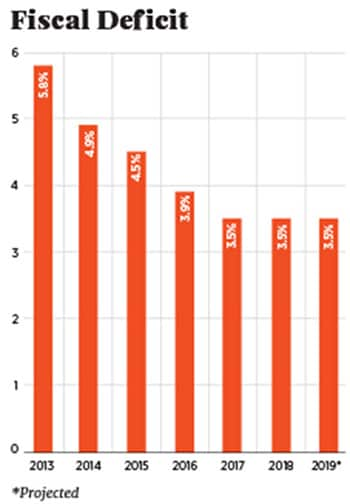Modi-Meter: How far did the NDA government deliver on its promises?
Fixing its balance sheet was the BJP-led government's biggest hit, and the inability to get faster GDP growth its biggest miss


Illustration: Sameer Pawar
Sacrifice the short term, focus on the medium to long term and things will work out fine. This government mantra has meant that it hasn’t shied away from taking difficult (some may argue flawed) decisions with the firm belief that it put the country’s economic future on the right path.
At times this has meant longer wait times—for instance, for resolving bank bad loans the government chose to enact the Insolvency and Bankruptcy Code and is patiently waiting for the courts to evolve the first set of jurisprudence around it. In other cases it has also waited for the pain that restructuring of how markets work entails—as evident in the implementation of the Real Estate Regulation and Development Act. Votaries argue that this has sacrificed short-term growth for a long-term future that is no doubt bright.
“An error that people make when assessing this government is that they think it has been a redux of the first NDA government. It has been anything but that,” says Venugopal Garre, director at Bernstein, a brokerage. He points out that 1999 to 2004 was all about big-ticket reforms, from the opening up of telecom to the reform of state electricity boards and the implementation of public private partnerships. There was a view that the NDA government then was too urban-focussed.
In contrast, the Narendra Modi-led government approach has been to patiently implementing a set of measures that can best be defined as incremental with no reforms of factor markets like land and labour. At the same time the government hasn’t ignored rural India. The Employment Guarantee Scheme is intact and new programmes have made electricity and cooking gas cylinders available. “There will probably be one big bang announcement to take care of the distress in agriculture,” says Garre.
As the government gears up to present its last budget, Forbes India spoke to a cross section of economists and business people to understand whether its record leaves a glass half full or empty. How has it stacked up on the implementation of its promises? Has it achieved its promise of ushering in ‘acche din’? And what can the electorate expect in the run-up to the elections? As one economist puts it, “While one can argue on whether enough has been achieved, the biggest takeaway is that we haven’t sacrificed future growth like we did in 2010-12 to achieve our present numbers.” 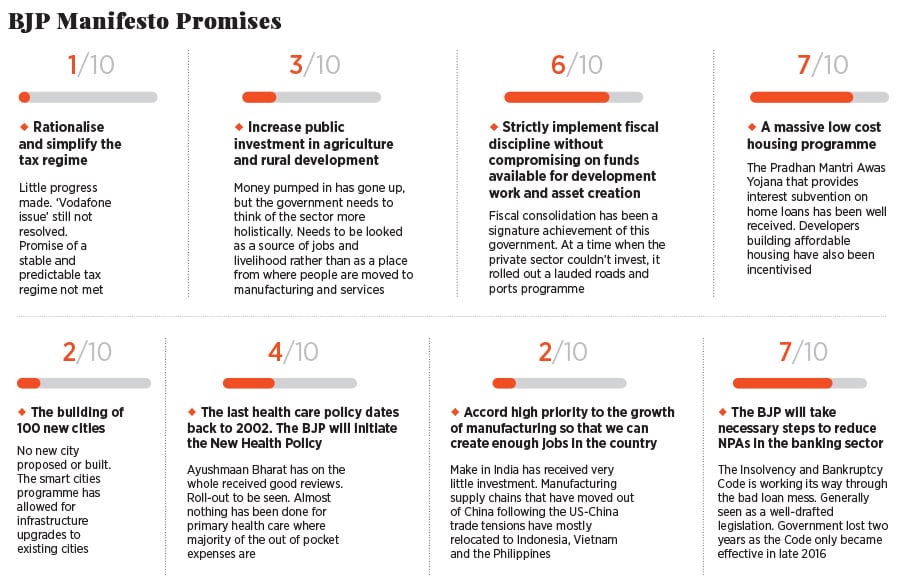 The Positives
The Positives
If there is one area where this government received an A rating it is in its ability to keep consumer price inflation under control. While its task was aided by the fall in oil prices, the low rate of growth in minimum support prices for wheat, rice and pulses also contributed to a large extent. In addition it mandated the Reserve Bank of India (RBI) to make targeting inflation its primary goal. The government also held firm in the drought years of 2014 and 2015, refusing to grant loan waivers and instead spending money on building roads. “What people don’t realise is that high inflation hurts the poor more. In hindsight, the 2009 fiscal stimulus proved to be damaging. Low inflation coupled with keeping home prices in check have resulted in substantial savings for the less well off,” says the head of research of a large foreign institutional investor.
Low inflation paved the way for the government to clean up its balance sheet with this year’s fiscal deficit target of 3.5 percent down from 4.9 percent in 2014. The budget numbers are now a lot more believable and investors on the whole have invested in government debt at lower rates through its tenure. There are still some items like the highway bonds that are off the government balance sheet but the number is much lower than with UPA-II. The biggest risk in 2019 investors point to is the election resulting in a coalition government that, due to the pushes and pulls of its various constituents, has to loosen the purse strings. 
Finance Minister Arun Jaitley will present the government’s interim budget on February 1
Image: Arvind Yadav / Hindustan Times via Getty Images Its philosophy of making every spent rupee count also had a drawback. It meant that there was no across the board bank recapitalisation that had been expected post May 2014. Instead it took its time in getting in place what many believe was its single biggest legislative achievement: The Insolvency Code put in place a clear path on how to deal with defaulters and backed the RBI in getting banks to declare the true extent of the problem. Sadly, this was accompanied with little reform on how government banks work. Getting them to lend again mostly proved to be a non-starter, crimping GDP growth, as did the enactment of the Goods & Services Tax (GST), another signature legislation.
Unlike what supporters had hoped, careful spending did not result in a pullback in spends on the Employment Guarantee Scheme or rural health—two signature UPA schemes. If anything, government spending moved up in areas as diverse as providing subsidised cooking gas, electrifying rural homes, keeping our cities clean and opening zero balance bank accounts. At the same time, it’s too early to comment on the success of programmes like Make in India and Skill India.
One area where the government scored well was in foreign policy. “It made it a lot more commercially oriented,” says Abheek Barua, chief economist at HDFC Bank. This led to cheap money coming in from Japan International Cooperation Agency and KfW (the German government development bank) to fund a host of metro projects as well as the proposed bullet train. 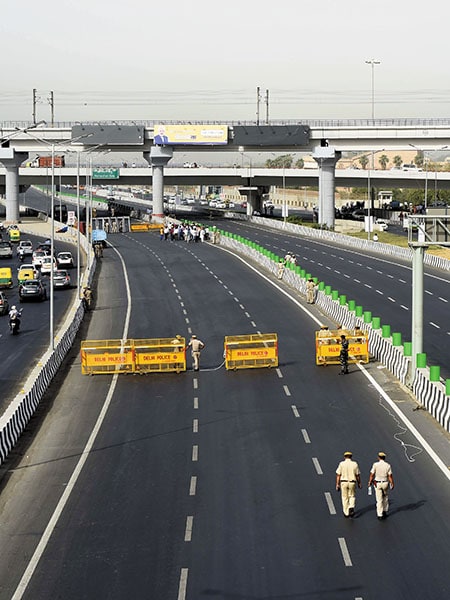
Instead of granting loan waivers, the government spent money on building roads
Image: Arvind Yadav / Hindustan Times via Getty Images Work in Progress
A clear miss for this government has been its failure to rein in the taxman. Their targets, if anything, have increased and at a time when nominal GDP growth is the same as gross value added, tax collections have not shown the buoyancy they did during inflationary periods. Direct tax collections rose by 14 percent in April-December 2018 and GST collections have mostly been below the ₹100,000 crore a month target.
Sectors that took a regulatory hit also received inadequate attention. Power and coal remained comatose. Several power plants are expected to go down the insolvency route while the coal auctions done in record time have failed to live up to promise. The lack of availability of coal has led to an increase in coal imports. Mining hasn’t restarted in a meaningful manner and corporate balance sheets haven’t allowed the resumption of private sector capex. Little has been done to incentivise companies to invest and the fear, as articulated in the Economic Survey, is that an investment slowdown can persist for decades and doesn’t usually reverse itself automatically. As a result, GDP growth hovered at about 7 percent for much of this period.
Agriculture has been another signature failure. The sector was viewed as a backwater—a place from where people had to be moved to manufacturing. The lack of investment has meant stagnating incomes and a poor start to the promise of doubling farmer incomes by 2022. Several market voices argue that with India having largely missed the manufacturing bus, its high time the government starts seeing agriculture and low-end services as an engine of growth, and starts the long task of asset creation in the sector.
The over reliance on the prime minister’s office and bureaucrats for policy making took a toll on both the quality of ideas as well as their implementation. “They couldn’t replicate the Gujarat model at the Centre. A country as large as India requires many more focus areas and it can be argued that primary health and education lost five years,” says a policy maker. In addition, lateral talent that had joined the government with much fanfare has left.
Barua disagrees with the notion that their departure harmed policy making. “There was this impression that these were crusaders who took a couple of years off from their cushy jobs in the US and came to save India from the darkness. It takes two to tango and there was a lack of receptivity on their part as well as an inability to understand the workings of the Indian system and bureaucracy,” he says.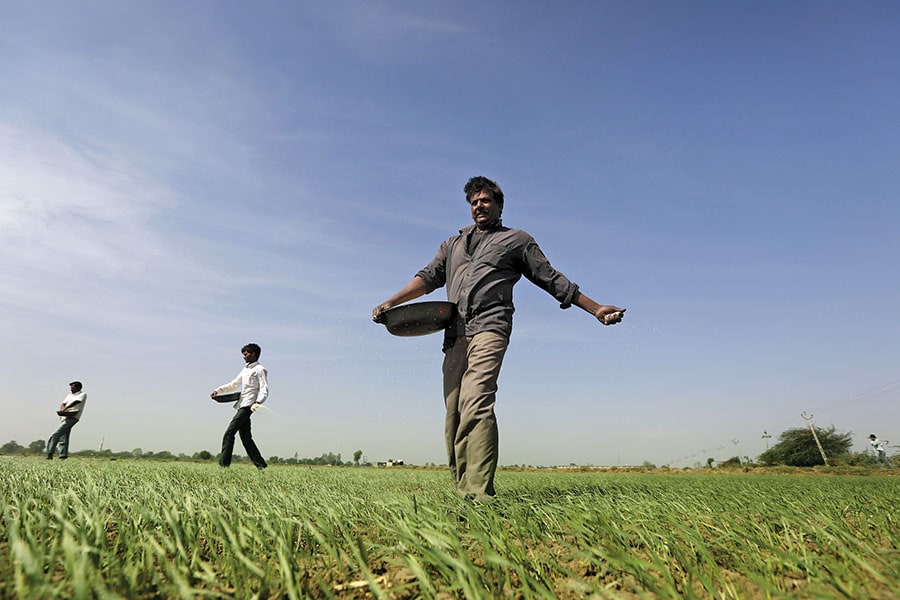 Agriculture has been a significant failure of the government
Agriculture has been a significant failure of the government
Image: Amit Dave / Reuters
Leading up to the Election
The months leading up to the election are being keenly watched for two reasons. What does Modi go with to the electorate? Clearly he’s managed to get a conversation going with them. Schemes like Swachh Bharat, which may have had a limited impact in the metros have worked in smaller cities like Surat and Indore, and citizens take pride in keeping their cities clean. He’s also put his weight behind the rural electrification programme and subsidised cooking gas. Whether this amounts to ‘acche din’ is up for debate, but it is unlikely that the government will use the slogan for the 2019 campaign. Expect a lot of ‘acche din’ memes from the opposition. 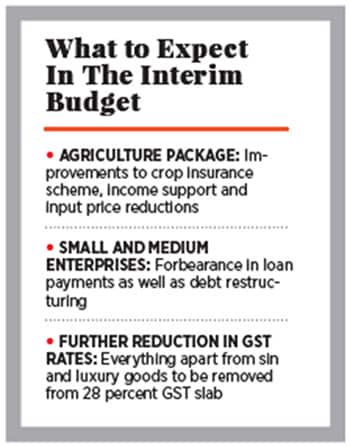 What remains to be seen is if the government goes to the electorate on the strength of its performance in the last four years or if there is a big bang farm announcement. It clearly does not have the fiscal space that UPA-I had when it announced a farm loan waiver in 2009. “I’ve been heartened by the fact that the prime minister has said waivers don’t help. It shows that they are probably thinking about a longer term income support scheme where the state doesn’t necessarily bear the full burden,” says an economist.
What remains to be seen is if the government goes to the electorate on the strength of its performance in the last four years or if there is a big bang farm announcement. It clearly does not have the fiscal space that UPA-I had when it announced a farm loan waiver in 2009. “I’ve been heartened by the fact that the prime minister has said waivers don’t help. It shows that they are probably thinking about a longer term income support scheme where the state doesn’t necessarily bear the full burden,” says an economist.
One option being considered is the Telangana model where landowners get ₹4,000 per acre er season. A national rollout would cost ₹140,000 crore and mean an increase in the fiscal deficit next year. Add to that ₹50,000 crore in interest subvention schemes for loans plus adding fertiliser subsidy to make the size of the package look bigger. Hiking of minimum support prices has for the time being been ruled out on account of its inflationary impact. “If they don’t come up with a big bang announcement, the story is over for them,” says Garre. There has also been some relief given to small and medium enterprises that have had to bear the twin shock of demonetisation and GST.
For now, it remains to be seen how the government markets its slow and steady approach at the hustings. Past records—Chandrababu Naidu’s 2004 defeat being a prime example—have shown that good economics does not always make for good politics. Equally, freebies—Rajasthan voted out Ashok Gehlot in 2013—also don’t always mean election wins. With a strong fiscal base in place, a 2019 NDA win could pave the way for faster growth in the decade ahead and take India to middle income status without the boom-bust cycles that have plagued many developing economies.
First Published: Jan 21, 2019, 11:03
Subscribe Now